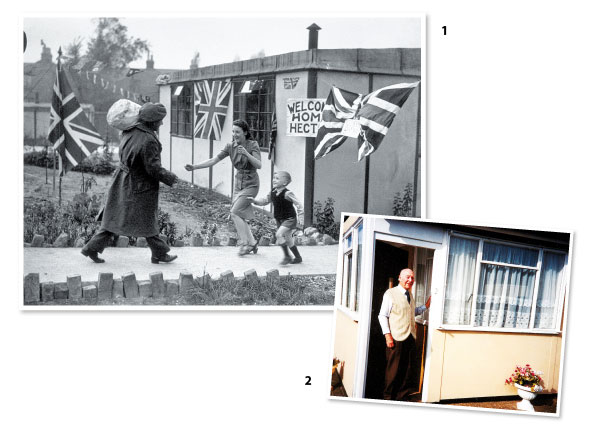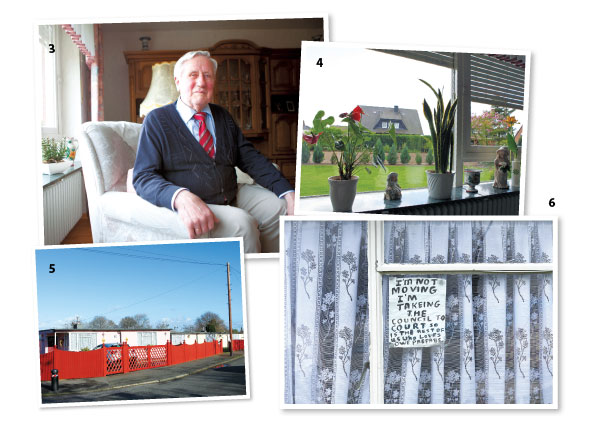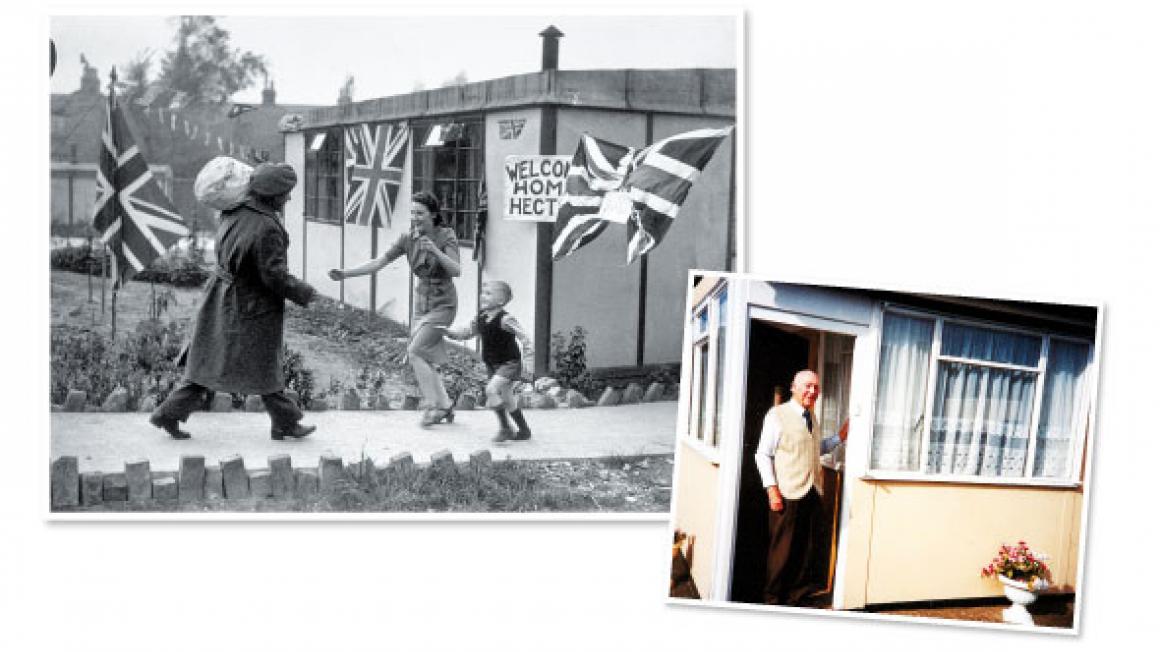THE END of PREFAB BRITAIN
Prefab houses were put up across Britain as a temporary solution to the post-war housing crisis and most were allocated to returning soldiers and their families who had lost their homes during the Blitz. These two-bed council homes offered cheap rent but also luxuries previously inaccessible to their new tenants: immersion heaters, fitted kitchens, indoor bathrooms and spacious gardens.
‘To find a bathroom inside was magic,’ recalls Eddie as he shows me around his modest home. ‘And a refrigerator! Ordinary people didn’t have them.’
 1. A returning serviceman arrives at his new prefab in the 1940s 2. Eddie O’Mahony at his beloved home on the Excalibur Estate
1. A returning serviceman arrives at his new prefab in the 1940s 2. Eddie O’Mahony at his beloved home on the Excalibur EstateFactories no longer needed for the war effort were turned over to the production of prefabricated parts that could be transported and constructed into a house in a day.
The Excalibur Estate – which consists of 186 such homes – as well as 150,000 other prefabs around the country were meant as a stopgap, their life span thought to be one or two decades at most. Although many have since been replaced, thousands of Britons, including Eddie, have been fighting to remain in their prefabs.
The Excalibur Estate still breathes the post-war air of make-do-and-mend. Walking up roads lined with Victorian two-storey houses and others with council blocks, you turn a corner and find yourself in what resembles a holiday village, composed of squat, pastel-coloured homes with flat roofs and picket fences.
The Excalibur was a strong community, and its initial inhabitants, most of whom had young children, were thrilled not to be living in overcrowded housing.
‘When my wife Ellen opened the door she said, “What a lovely big hall, we can get the pram in here,”’ recalls Eddie.
Back doors were not locked in those days and front and back gardens thrived as makeshift allotments, then as manicured gardens. It is through sheer determination that the Excalibur prefabs have survived this long but Lewisham Council has finally started to redevelop the estate.
The process of ‘decanting’ has already begun and more than 30 prefabs have come down, while others stand empty, their gardens overgrown with weeds. In their place will go up new flats and houses.
‘I close my eyes when I pass the ones that are boarded up,’ says Eddie dejectedly. ‘I’ve loved this place from day one.’
But the prefabs have not been forgotten. Max, now 88, who lives in a small town near Munster in Germany, remembers only too well what it is like to lose a home. While still a POW in England, his family’s farm in Silesia was annexed to Poland after the war. ‘I didn’t have any home I could say was mine any more.’
Max eventually returned to Germany in 1948 and – picking up where he left off when he was drafted into the army – went to live and work on a farm. Eventually he moved into his own, newly built brick house, married and had a family. Sitting in his neat living room, Max recalls that in 2009 he read an article in a German newspaper about the prefabs – ‘that Eddie and the others were fighting the council to keep them. So I wanted to get in touch and say, “I helped to build them, I remember. I want to help you.”’
 3. Former prisoner of war Max Hentschel, who helped to build the Excalibur Estate prefabs, at his home in Germany 4. A view of Max’s carefully tended garden 5 and 6 Despite protests (below left) nearly all of the residents of the Excalibur Estate will lose their homes
3. Former prisoner of war Max Hentschel, who helped to build the Excalibur Estate prefabs, at his home in Germany 4. A view of Max’s carefully tended garden 5 and 6 Despite protests (below left) nearly all of the residents of the Excalibur Estate will lose their homesAnd so Max and Eddie struck up a correspondence. ‘I was surprised the prefabs are still standing,’ says Max, in the faltering English he picked up while doing gardening jobs for British families as a POW. ‘It’s very sad they are losing their prefabs. It is not right to take away the home of someone who has lived there for 70 years.’
Over tea, we decide to call Eddie. ‘I would like to thank the Germans for my home,’ he tells Max. ‘The first winter we were here, we had three feet of snow and I thought to myself: “The roof is going to collapse” – but it didn’t. The Germans made a marvellous job of it. I want to shake your hand, Max – I’ve been very happy here.’
Max takes me on a tour of his garden. We stop by a rectangle of upturned soil. ‘Kartoffel!’ he points out proudly. Growing potatoes in his back yard cannot possibly replace his lost farm – but it has had to do. Eddie, I tell him, once a keen gardener himself, would surely be impressed.
English Heritage has granted grade II preservation status to the six prefabs on the Excalibur that retain the most original features. Eddie’s is not one of them. I wonder again why it was important for Max to get in touch with Eddie and the other prefab residents.
Looking thoughtfully across the garden, he says: ‘Well, it’s not nice to lose your home, is it?’
The Prefab Museum, 17 Meliot Road, London SE6 1RY, is open every Saturday, 11am to 5pm. Prefab Homes, by Elisabeth Blanchet, is published by Shire, priced £7.95.



